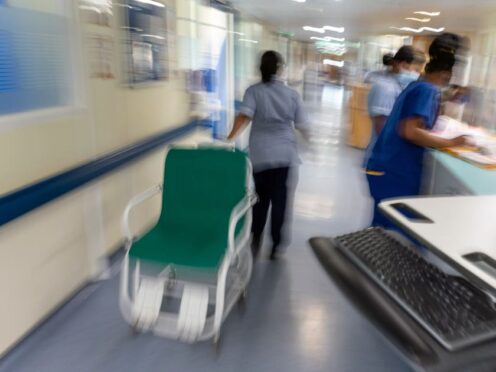
Government action to help the NHS could also boost the economy and productivity, a report has said.
The economics expert who heads the Fraser of Allander Institute think tank at Strathclyde University however warned that as things stand, economic growth in Scotland is “fragile and may be blown off course”.
Professor Mairi Spowage was speaking as the institute published its latest economic commentary, which found that while Scotland avoided recession last year overall, the “big picture growth in the Scottish economy has been lacklustre from the start of 2023 onwards”.
Average quarterly growth in the economy in Scotland was just 0.1%, the think tank said.
Prof Spowage, director at the institute, said the “mixed bag of economic news we are seeing for both Scotland and the UK at the moment could give reasons for either pessimism or optimism”.

She added: “On the one hand, the economy returning to growth in January and inflation falling faster than expected support our view that we will return to growth in 2024 overall.
“On the other hand, this growth is fragile and may be blown off course by events, particularly given geopolitical uncertainty this year.”
The report highlighted the economic impact of issues within the NHS, which it said is “facing significant pressures” despite having record numbers of staff and record investment from the Scottish Government.
With lower numbers of day case procedures, outpatient appointments and inpatient admissions compared to pre-pandemic levels, the report said Scotland has seen a “significant rise in short-term sickness absence” – rising to 3% in 2022, above pre-pandemic levels of 2%.
The report highlighted the “implications for productivity” of people waiting for treatment.
It said: “Helping the National Health Service to recover is key for the Scottish Government, not only to ensure that health services can meet the demands of the population, ensuring everyone has access to the care they require.
“However, also to ensure that the implications for the labour market are reduced, to ultimately reduce many of the staff shortages in the economy and boost productivity.”
The report also warned it is “uncertain” how the Scottish Government will meet its targets for tackling child poverty, questioning if the Scottish child payment benefit has had a “lesser impact than expectations”.
Holyrood has set targets to reduce the number of youngsters living in poverty, but the report noted: “The most recent estimate of relative child poverty in Scotland was 26%, well above the Scottish Government’s interim target of 18% by 2023-24.
“The concern, therefore, is that whilst the ambition of the Government to reduce poverty is clear, and some progress evident, the policies put in place are not having their expected impact.”
It said within “tight” Government finances “substantial resources” have been allocated to tackling poverty, but added: “No significant progress has been shown.
“Therefore, how the Government seeks to achieve their own targets is now more uncertain.”
Overall, the economic commentary, which is sponsored by Deloitte, kept its forecasts for growth unchanged, predicting Scotland’s economy will expand by 0.6% in 2024, 1.1% in 2025 and 1.2% in 2026.
Douglas Farish, head of tax for Scotland at Deloitte, said: “Although it’s encouraging that Scotland avoided a technical recession in the latter half of last year, this quarter’s economic commentary still paints an ambivalent view of the nation’s current economic position, with overall growth lacklustre in 2023.
“The cost-of-living crisis continues to take a toll on household finances, and our latest State of the State report found that 60% of the Scottish public believe the crisis will get worse still, albeit dropping from 75% last year.”
Wellbeing Economy Secretary Mairi McAllan said: “The Scottish Government is committed to a fair, green and growing economy and it is encouraging that this report forecasts an improving economic outlook.
“Despite the challenging backdrop of Brexit and Covid, the Scottish economy continues to make positive progress in comparison to the UK as a whole, with GDP growth per person of 10.8% in Scotland since 2007, compared to 5.6% in the UK. The latest GDP figures show an increase of 0.6% for Scotland in January 2024 – compared to 0.2% for the UK as a whole – and Scotland’s economy has not entered recession, unlike the UK.
“We are making the most of every resource available to continue to grow the economy through investment of more than £5 billion across government in the Scottish Budget 2024-25. This includes £66.9 million to kickstart our commitment to invest £500 million over the next five years in Scotland’s offshore wind supply chain, and increasing investment in digital connectivity to £140 million.”

Enjoy the convenience of having The Sunday Post delivered as a digital ePaper straight to your smartphone, tablet or computer.
Subscribe for only £5.49 a month and enjoy all the benefits of the printed paper as a digital replica.
Subscribe